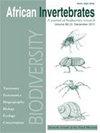从非洲热带蜜蜂目录中获得260年分类研究的见解
IF 1.1
4区 农林科学
Q3 ENTOMOLOGY
引用次数: 1
摘要
我们分析了非洲热带地区(不包括阿拉伯半岛南部和索科特拉岛)国家范围内独居蜜蜂(即不包括Apismellifera)的分布记录。虽然不同国家对蜜蜂物种数量的估计可以用气候、植被或地形的差异来解释,但我们得出的结论是,所观察到的差异主要是由于不同国家取样努力或分类学研究强度的差异。我们描述了蜜蜂分类学的三个时代。每年最高的物种描述率出现在20世纪上半叶,当时还没有普遍的属型修订,而且当时的重点是巩固知识和开发鉴定关键。我们还研究了模式标本的分布位置,包括所有的初级模式和总模式。大多数类型都被安置在西欧。我们描述了非洲热带蜜蜂目录(CAB),一个生物多样性信息系统和相关的GBIF清单,这是该系统的标准化,出版的输出。在修订后的CAB中,所有非洲热带蜜蜂属都被赋予了共同名称,其中许多是新的。本文章由计算机程序翻译,如有差异,请以英文原文为准。
Insights into 260 years of taxonomic research gained from the Catalogue of Afrotropical Bees
We analysed country-scale distribution records of solitary bees (i.e. excluding Apismellifera) in countries in the Afrotropical Region, excluding the southern Arabian Peninsula and Socotra. Although different country estimates of bee species numbers can be explained by differences in climate, vegetation or topography, we concluded that the observed differences are mainly due to differences in sampling effort or taxonomic research intensity in different countries. We characterised three eras of bee taxonomy. The highest rate of species description per annum occurred during the first half of the 20ᵗʰ Century, before generic revisions were prevalent, and when the focus was on consolidating knowledge and developing identification keys. We also researched the locations of type specimens, which included all primary types and syntypes. Most types are housed in western Europe. We describe the Catalogue of Afrotropical Bees (CAB), a biodiversity information system and related GBIF checklist that is the system’s standardised, published output. In the revised CAB, all Afrotropical bee genera have been given common names, many of which are new.
求助全文
通过发布文献求助,成功后即可免费获取论文全文。
去求助
来源期刊

African Invertebrates
生物-动物学
CiteScore
1.00
自引率
0.00%
发文量
6
审稿时长
>12 weeks
期刊介绍:
African Invertebrates is an international peer-reviewed, open-access journal that focuses primarily on the taxonomy, systematics, biogeography, and palaeontology of Afrotropical invertebrates, whether terrestrial, freshwater or marine. Aspects concerning biology, ecology, and conservation may also be considered where these relate to the primary focus areas. Papers dealing solely with biology, ecology, physiology, pests and pest control should be submitted elsewhere.
 求助内容:
求助内容: 应助结果提醒方式:
应助结果提醒方式:


